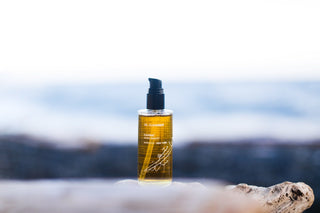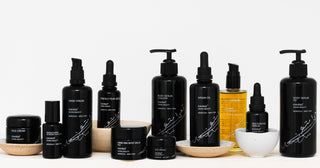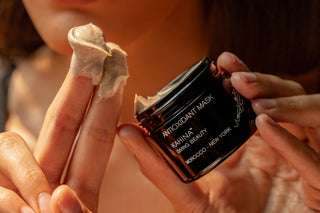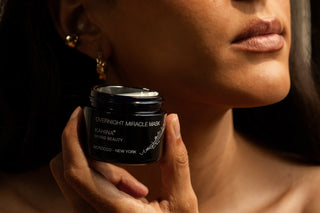Many of our customers are already dyed-in-the-wool natural skincare users. Others, are just making the switch. For those of you in the second category, we at Kahina Giving Beauty know that there is a lot of new information to absorb. This list was published in Natural Solutions Magazine. Of course, Kahina products are free of all of these:
Our Formidable 15-Toxic Ingredients to Avoid in Skincare
Natural Solutions, in collaboration with Whole Foods, developed this list of what you don't want in your products:
1. Synthetic fragrances often contain phthalates (pro- nounced THAY-lates), synthetic chemicals commonly used to stabilize fragrances and make plastic more pliable. These endocrine disrupters mimic hormones and may alter genital development. Avoid products that list fragrance as an ingredi- ent unless the label states that it's derived from essentials oils, or look for a phthalate-free label on the packaging.
2. Parabens, ubiquitous in skincare, preserve other ingredi- ents and extend a product's shelf life-but these antimicrobial chemicals also have hormone-disrupting effects.
3. Ureas, formally known as diazolidinyl urea, imidazolidi- nyl urea, or DMDM hydantoin and sodium hydroxymethyl- glycinate, are preservatives that have the potential to release formaldehyde in very small amounts and are a primary cause of contact dermatitis.
4. 1,4-dioxane, a chemical carcinogen, is created when ingredients are processed with petroleum-derived ethylene oxide. Common ethoxylated compounds include sodium laureth sulfate and polyethylene glycol (often listed as PEG). To avoid it, skip any product with the following ingredients: myreth, oleth, laureth, ceteareth (or any other -eth), PEG, polyethylene, polyethylene glycol, polyoxyethylene, or oxy- nol.
5. Petrochemicals are derived from crude oil. Petroleum- based ingredients such as petrolatum, mineral oil, and paraffin (derived from nonrenewable sources) form a barrier when applied to the skin that does not allow it to breathe and can clog pores.
6. MEA/DEA/TEA are "amines" (ammonia compounds) and can form harmful nitrosamines when they come in contact with nitrates. Used as foaming agents, synthetic stabilizers, and to adjust the pH of cosmetics, they can cause allergic reactions, eye irritation, and dryness of the hair and skin.
7. Sulfates, such as sodium lauryl and sodium laureth, are harsh detergents that give cleansers, soaps, and shampoos their latherability. Often derived from petroleum, sulfates can also come from coconut and other vegetable oils that can be contaminated with pesticides. Sulfates can cause eye irritation and skin rashes.
8. Chemical sunscreens, such as oxybenzone and octyl methoxycinnamate, have been shown to disrupt endocrine activity. Titanium dioxide and zinc oxide are safer alternatives.
9. Quats, such as benzalkonium chloride, steardimonium chloride, cetrimonium bromide, and cetrimonium chloride, give a positive charge to conditioners in order to prevent static. They are necessary for conditioners, but we have allowed only the mildest quats in our Beauty With a Conscience standard: guar hydroxypropyltrimonium chloride, hydroxypropyltrimo- nium oligosaccharide, and SugaQuats.
10. Antibacterial compounds, such as triclosan and chlorphenesin, do not break down in the environment and may contribute to bacterial resistance.
11. Synthetic polymers, such as sodium polyacrylate and carbomer, come from petroleum and give viscosity to skincare products. They are highly processed and their manufacture creates toxic by-products.
12. Synthetic colors are made from coal tar. They con- tain heavy metal salts that may deposit toxins onto the skin, causing skin sensitivity and irritation. Animal studies have shown almost all of them to be carcinogenic. They will be labeled as FD&C or D&C, followed by a color and a number.
13. Chelators, such as disodium EDTA and tetrasodium EDTA, are used in personal care products to remove impurities from low-quality raw materials. They do not readily biode- grade in the environment.
14. Nanos are a new technology with inconclusive but potentially hazardous study results. Research suggests that when tiny nano particles penetrate the skin, they may cause cell damage.
15. Animal testing: A grim history of cruelty to animals lies behind many cosmetic ingredients. But scientists are developing new technologies to test cosmetics before a European Union ban on animal testing begins in March 2009.
Blog
Toxic Ingredients to avoid in Skincare
More Stories

Kahina Essentials for Summer-Ready Skin
As the weather warms and the days stretch out, your skin starts sending new signals. It’s craving hydration but without the weight. It wants to glow but without the makeup,...

Kahina Named Best US Natural and Organic Brand by Beauty Shortlist
For the seventh time, the Beauty Shortlist Awards have recognized our products among the best, including Best Argan Brand and Best Natural/Organic Brand - USA. These globally respected awards...

This Product Keeps Flying Off the Shelves!
“THE BEST" "This is a hero product! It is gentle and yet so very effective. It has a subtle aroma. It has such fine granules, gentle enough for daily use....

Our Award Winning Moisture Mask Got A Makeover
“I’ve experienced my skin firming up, especially around the cheeks and eye area. I love the list of ingredients. My skin can’t seem to get enough of it. I am...
